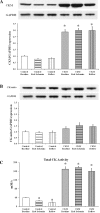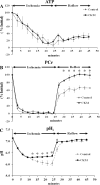Creatine kinase overexpression improves ATP kinetics and contractile function in postischemic myocardium
- PMID: 22886411
- PMCID: PMC3469706
- DOI: 10.1152/ajpheart.00268.2012
Creatine kinase overexpression improves ATP kinetics and contractile function in postischemic myocardium
Abstract
Reduced myofibrillar ATP availability during prolonged myocardial ischemia may limit post-ischemic mechanical function. Because creatine kinase (CK) is the prime energy reserve reaction of the heart and because it has been difficult to augment ATP synthesis during and after ischemia, we used mice that overexpress the myofibrillar isoform of creatine kinase (CKM) in cardiac-specific, conditional fashion to test the hypothesis that CKM overexpression increases ATP delivery in ischemic-reperfused hearts and improves functional recovery. Isolated, retrograde-perfused hearts from control and CKM mice were subjected to 25 min of global, no-flow ischemia and 40 min of reperfusion while cardiac function [rate pressure product (RPP)] was monitored. A combination of (31)P-nuclear magnetic resonance experiments at 11.7T and biochemical assays was used to measure the myocardial rate of ATP synthesis via CK (CK flux) and intracellular pH (pH(i)). Baseline CK flux was severalfold higher in CKM hearts (8.1 ± 1.0 vs. 32.9 ± 3.8, mM/s, control vs. CKM; P < 0.001) with no differences in phosphocreatine concentration [PCr] and RPP. End-ischemic pH(i) was higher in CKM hearts than in control hearts (6.04 ± 0.12 vs. 6.37 ± 0.04, control vs. CKM; P < 0.05) with no differences in [PCr] and [ATP] between the two groups. Post-ischemic PCr (66.2 ± 1.3 vs. 99.1 ± 8.0, %preischemic levels; P < 0.01), CK flux (3.2 ± 0.4 vs. 14.0 ± 1.2 mM/s; P < 0.001) and functional recovery (13.7 ± 3.4 vs. 64.9 ± 13.2%preischemic RPP; P < 0.01) were significantly higher and lactate dehydrogenase release was lower in CKM than in control hearts. Thus augmenting cardiac CKM expression attenuates ischemic acidosis, reduces injury, and improves not only high-energy phosphate content and the rate of CK ATP synthesis in postischemic myocardium but also recovery of contractile function.
Figures




Similar articles
-
Maintaining energy provision in the heart: the creatine kinase system in ischaemia-reperfusion injury and chronic heart failure.Clin Sci (Lond). 2024 Apr 24;138(8):491-514. doi: 10.1042/CS20230616. Clin Sci (Lond). 2024. PMID: 38639724 Free PMC article. Review.
-
Dual cardiac contractile effects of the alpha2-AMPK deletion in low-flow ischemia and reperfusion.Am J Physiol Heart Circ Physiol. 2007 Jun;292(6):H3136-47. doi: 10.1152/ajpheart.00683.2006. Epub 2007 Mar 2. Am J Physiol Heart Circ Physiol. 2007. PMID: 17337600
-
Pyruvate dehydrogenase influences postischemic heart function.Circulation. 1995 Apr 1;91(7):2071-9. doi: 10.1161/01.cir.91.7.2071. Circulation. 1995. PMID: 7895366
-
Protective effects of dimethyl amiloride against postischemic myocardial dysfunction in rabbit hearts: phosphorus 31-nuclear magnetic resonance measurements of intracellular pH and cellular energy.J Thorac Cardiovasc Surg. 1996 Sep;112(3):765-75. doi: 10.1016/S0022-5223(96)70063-6. J Thorac Cardiovasc Surg. 1996. PMID: 8800166
-
Investigating cardiac energetics in heart failure.Exp Physiol. 2013 Mar;98(3):601-5. doi: 10.1113/expphysiol.2012.064709. Epub 2012 Sep 14. Exp Physiol. 2013. PMID: 22983996 Review.
Cited by
-
The Pitfalls of in vivo Cardiac Physiology in Genetically Modified Mice - Lessons Learnt the Hard Way in the Creatine Kinase System.Front Physiol. 2021 May 14;12:685064. doi: 10.3389/fphys.2021.685064. eCollection 2021. Front Physiol. 2021. PMID: 34054587 Free PMC article. Review.
-
Cardiac 31P MR spectroscopy: development of the past five decades and future vision-will it be of diagnostic use in clinics?Heart Fail Rev. 2023 Mar;28(2):485-532. doi: 10.1007/s10741-022-10287-x. Epub 2022 Nov 24. Heart Fail Rev. 2023. PMID: 36427161 Review.
-
Maintaining energy provision in the heart: the creatine kinase system in ischaemia-reperfusion injury and chronic heart failure.Clin Sci (Lond). 2024 Apr 24;138(8):491-514. doi: 10.1042/CS20230616. Clin Sci (Lond). 2024. PMID: 38639724 Free PMC article. Review.
-
Synergistic effect on cardiac energetics by targeting the creatine kinase system: in vivo application of high-resolution 31P-CMRS in the mouse.J Cardiovasc Magn Reson. 2023 Feb 6;25(1):6. doi: 10.1186/s12968-023-00911-6. J Cardiovasc Magn Reson. 2023. PMID: 36740688 Free PMC article.
-
Normal cardiac function in mice with supraphysiological cardiac creatine levels.Am J Physiol Heart Circ Physiol. 2014 Feb;306(3):H373-81. doi: 10.1152/ajpheart.00411.2013. Epub 2013 Nov 22. Am J Physiol Heart Circ Physiol. 2014. PMID: 24271489 Free PMC article.
References
-
- Banerjee A, Grosso MA, Brown JM, Rogers KB, Whitman GJ. Oxygen metabolite effects on creatine kinase and cardiac energetics after reperfusion. Am J Physiol Heart Circ Physiol 261: H590–H597, 1991 - PubMed
-
- Bittl JA, Balschi JA, Ingwall JS. Contractile failure and high-energy phosphate turnover during hypoxia: 31P-NMR surface coil studies in living rat. Circ Res 60: 871–878, 1987 - PubMed
-
- Bittl JA, DeLayre J, Ingwall JS. Rate equation for creatine kinase predicts the in vivo reaction velocity: 31P NMR surface coil studies in brain, heart, and skeletal muscle of the living rat. Biochemistry 26: 6083–6090, 1987 - PubMed
-
- Brindle KM, Radda GK. 31P-NMR saturation transfer measurements of exchange between Pi and ATP in the reactions catalysed by glyceraldehyde-3-phosphate dehydrogenase and phosphoglycerate kinase in vitro. Biochim Biophys Acta 928: 45–55, 1987 - PubMed
Publication types
MeSH terms
Substances
Grants and funding
LinkOut - more resources
Full Text Sources
Molecular Biology Databases
Research Materials
Miscellaneous

